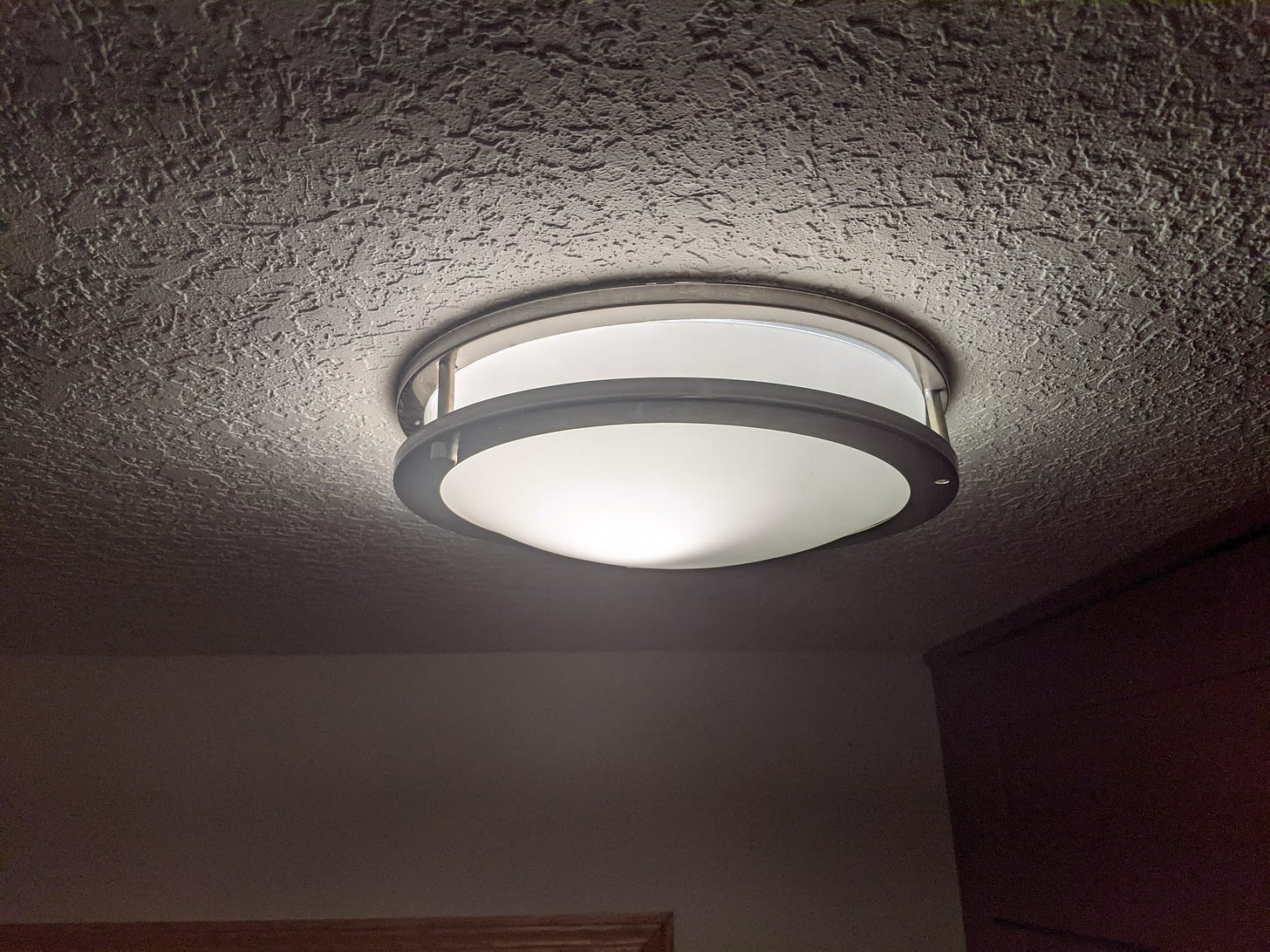Keep It Simple
no fuss, no muss
MYTH / NONSENSE / COMMON SENSE

The Inspiration
A friend recently recommended a show on The History Channel. The channel is not available on my streaming service. While poking around for more information on the show in question I noted a reference to the long-forgotten “Ancient Astronauts” that emerged in my childhood. Before I knew it, a topic had been inspired. When I came in from an errand later the next day, one of my lights was out. Perhaps a post about sticking with the likely option was in order.
The Setup
Ockham’s Razor returns today. It is a steady companion for me and is useful to everyday living. I included my image used previously for Ockham’s Razor in case that you did not see the previous post(s) that mentioned the principle.
The other day, I walked into my entryway via the garage. The hallway has two lights in it. Both of the lights are controlled by two different switches in different locations. Such a setup, to an electrician, is referred to as a three-way switch. Either one of the switches on the wall can control the on/off of the pair of lights. This is not a complex, but a common setup in most homes. I flipped the switch as I entered from the garage and only one of the lights turned on. I went to the other switch and flipped it on and off with the same result. It is time for Ockham’s Razor.
There are only a few possibilities of what is going wrong that come to mind. I am afraid there are people in this world who might have even more possibilities!
The bulb in the light not working had failed.
The socket in the light not working had failed.
The light fixture not working had failed.
The wiring at one or more of the switches had failed or was loose.
One or both of the switches wired had failed.
Ockham’s razor is a common-sense engine. While each of the possible conditions above is POSSIBLE, some are more likely than others. Since I always hated those questions that did not include extra details that MIGHT be significant, here is additional information about “the light that did not light”:
The light fixture was purchased at IKEA and has an unusual bulb type.
While we are all used to bulbs that screw in, some European bulbs are inserted and twisted with prongs.
For this light fixture, I installed an adapter that changes the prongs to threaded so I can use a conventional bulb on Amazon.
The light fixture has an LED bulb in it.
Given the information above, which of the five possible explanations was the problem? If you are not interested in playing, jump ahead to the next section. Here are some photos of the light fixture.
Ockham’s razor (keep it simple) is an endearing principle. It comes down to checking the obvious and simplest explanations FIRST. I COULD HAVE retrieved my electrical tester, removed the cover plates from the switches, and checked the continuity of the switches after removing them from the boxes mounted in the walls. Although this might become useful knowledge, it was a wiser decision to remove the glass cover on the light fixture, remove the bulb, and test it in a nearby lamp. I thought it unlikely the bulb was bad since an LED bulb should nominally last for 10+ years but a quick check was worthwhile. The bulb lit up in the other lamp so I could exclude option 1 of the possibilities. Hallelujah!
I returned to the fixture and removed the adapter shown in the photos above. I cleaned the contacts on the adapter with a pencil eraser, re-inserted it into the fixture, and screwed in the bulb. Voila, the light was working again. Before I encourage some sarcastic responses about my prowess as an electrician, I realize what I described here was trivial in many ways. I have a greater point to make in my closing paragraphs. The very best thing about this story so far is just how much effort and wasted time can be avoided by training ourselves to remain aligned with our common sense when presented with much less likely possibilities.
Ockham to the Rescue
As a young boy, there were popular books purporting to explain so much of what emerged on earth as due to “ancient astronauts” in books such as “Chariots of the Gods”. One of my favorite explanations that are now broadly accepted was how did large stones get from where they were excavated to where they were stacked before heavy machinery whether at Stonehenge or at the Pyramids at Giza. Heavy rocks have been shaped and moved all over the world for thousands of years in lots of different places. The creation of a mystical or an unlikely explanation, while POSSIBLE, is a strange conclusion to jump to when there is a lot of evidence of a simple explanation. Ancient astronauts have been offered as an explanation and that they supervised and guided the construction in hindsight is absurd.
There is no doubt that such an explanation can sell a lot of books. In many ways, this is not unlike the appeal of conspiracy theories that can reinforce what our brains WANT to believe. The absurdity, to me, of the ancient astronauts from an advanced civilization sharing all this knowledge, seems straightforward. The pyramids, all over the planet are almost always ornate graves to leaders who the culture believed were GODS! In what circumstance can a spaceship full of advanced civilization visitors appear, share incredibly advanced knowledge, yet we stick with the premise that one of our residents retains a God-like status and still deserves a really cool grave.
Wetting the sand and dragging the rocks on a sled is more likely. Everyone is entitled to their beliefs. It is worthwhile to exhaust other explanations of how something happened before going off the deep end. Whatever it is that you embrace as an explanation of ANYTHING, I encourage you to consider the simpler, more obvious explanations before solidifying your beliefs. We might all go a long way toward rejecting ideas that are presented to us in our daily lives if we avoid the highly unlikely explanations UNTIL we give consideration to the obvious explanation.
Pyramids, all over the world are amazing to explore and consider. In an earlier post, I wrote about the Babylonians and their early contributions to mathematics. It seems many cultures were obsessed by the symmetry of the triangle and hence the pyramid. Unless the ancient astronauts decided to make a multi-stop trip at random spots all over the world, it seems a fool’s errand to consider “Chariots of the Gods”. It is more likely that the sky, sun, and stars as they had from the very beginning inspired them to look upwards when humans struggled to sharpen sticks and fashion wheels. Ockham’s Razor is handy.
Tonight’s music selection is in honor of how all of us are searching for the right answer to questions of all sorts. While Ockham’s Razor can be helpful at all times, some questions are a little more challenging. Here’s a song about the inspiration we may have found to explore space by even such far-fetched ideas as ancient astronauts. I much prefer the premise that we (1) figured out how to build monuments before heavy machinery, (2) eventually learned to make complex machinery, and now (3) spend our resources exploring space with the most complex of these machines yet devised. That exercise puts the wonder of our minds and our free will to explore what can be learned. I like that story a lot better and doesn’t depend on idle conjecture. This is a WONDERFUL story and celebrates the best in all of us. Enjoy the music.
23+







